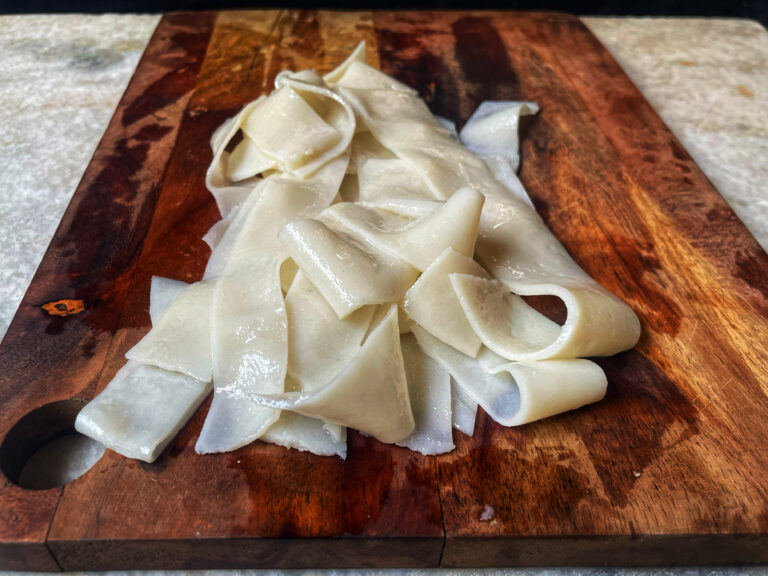
Homemade Fresh Rice Noodles (Ho Fun) | Kitchenstagram

These soft, slightly chewy flat rice noodles are a gluten-free favourite, perfect for a variety of dishes. Whether tossed in a flavourful stir-fry, added to a comforting noodle soup, or simply paired with a savoury sauce, they’re incredibly versatile. Commonly known as “ho fun” in Cantonese cuisine, these noodles are traditionally crafted with rice flour and often combined with Tapioca starch for added elasticity. They’re specially ideal for stir-fried classics like Thai Red Na or Pad see Ew, delivering that signature texture fans love. Homemade and easy to prepare, they’re a delicious and endlessly versatile in the kitchen.
What are Rice Noodles?
Rice noodles are a staple in many Asian cuisines, known for their delicate texture and quick cooking time. Made primarily from rice flour and water, dried rice noodles are simple and shelf-stable. Fresh rice noodles, on the other hand, often contain added starches to improve durability and shelf life. These noodles are already cooked and only need to be reheated or tossed into dishes, making them convenient but highly perishable. Their characteristics- soft, tender and naturally gluten-free- set them apart from wheat-based noodles. However, their softness also means they can become mushy if overcooked, so a gentle hand is needed during preparation.
Ingredients needed for Fresh Rice Noodles:
To make rice noodles, you’ll need a few key ingredients that contribute to their signature texture and taste,
Rice Flour: Rice flour is the star of the recipe, forming the base of the noodles. This recipe calls for regular rice flour, do not use glutinous rice flour. You can use store-bought rice flour or make your own by grinding uncooked rice into a fine powder.
Tapioca Starch: To improve elasticity and chewiness, tapioca starch is often added. This starch helps the noodles become more flexible and gives them a slightly springy texture by forming a gel-like consistency during cooking.
Water: Water is essential to bind the ingredients and create a smooth batter.
Salt: A pinch of salt enhances the overall flavour of the noodles, making them more savory and balanced.
Oil: Oil is needed to grease the pans and oiling the noodles, oiling the fresh rice noodles helps prevents them from sticking together and keep them soft. If you’re not cooking the noodles right away and will need to refrigerate them. Use any neutral flavoured oil like, vegetable oil, sunflower oil or canola oil. But avoid using avocado oil or coconut oil, as they tend to solidify in the fridge.
Important tips for Fresh Rice Noodles:
Getting fresh rice noodles just right can be tricky, but with a few key techniques, you’ll get soft, chewy and beautifully separated sheets every time.
Traditional Thai methods recommend kneading the dough with a bit of water before making the bater. This step encourages the starch to fully absorb moisture, creating a batter that yields noodles with a softer, shinier and pleasantly chewy texture. Take your time, longer kneading leads to better hydration.
Let the batter rest for 3-4 hours after mixing. This allows the rice flour to fully hydrate, improving the final texture. Before pouring, always stir the batter well- rice flour tends to settle at the bottom.
Using two flat-bottomed pans allows you to speed things up significantly. While one batch steams, the other can be prepped- cutting your time in half.
Non-stick pans are your best friend. Sticky pans leads to torn noodles. A smooth, slick surface ensures clean removal and beautiful noodles every time.
Fresh rice noodles are delicate. Avoid aggressive stirring with sharp-edged spatulas, especially metal ones. Instead, use a gentle flipping or pushing motion from the sides of the pan to keep noodles intact.
Rice noodles love to stick- both to each other and any surface they touch. To prevent this, lightly brush each layer and contact surface with oil. It makes a world of difference during steaming and later handling.
Storage Tips:
For best results, enjoy rice noodles the day they’re made. If storing for later, place the freshly cut noodles in an airtight container and refrigerate for up to two days. When you’re ready to use them, gently reheat by steaming or microwaving with a damp towel to restore their softness. Keep in mind that refrigerated rice noodles tend to become more fragile, so it’s important to store them after slicing. This helps minimize breakage and keeps the texture more pliable when reheated for dishes like stir-fries or soups.
Ingredients:
1 cup Rice flour
1/2 cup Tapioca starch
1 1/2 cup Water, (plus extra if needed)
1 tsp Salt
Vegetable oil
Preparation:
- Step 1: In a mixing bowl, add rice four and tapioca starch and whisk everything properly until just combined.

- Step 2: Add a little water at a time and mix just until a soft dough is formed. Knead the dough for 8-10 minutes.

- Step 3: Add the remaining water to the dough and dissolve the dough into a smooth batter. Check consistency. It should be the consistency of a thin coconut milk. Let the batter rest for 3-4 hours.

- Step 4: After resting for 3-4 hours add salt and stir to combine.

- Step 5: Use a large wok, make sure your non-stick pan fits comfortably in the wok. Fill the wok with water and place a ring mould in the middle of the wok and bring the water to a boil.

- Step 6: Brush your non-stick pan with light coating of oil and pour 1/4 cup of the batter in the pan. Tilt it a little so the batter covers the entire bottom of the pan. Place the pan carefully over the ring.

- Step 7: Cover the wok with lid and steam for 4-5 minutes or until just set. Brush the top of the noodle sheet with oil.

- Step 8: Now, take out the pan and allow it to cool completely. Repeat with the remaining batter to make the noodle sheets.

- Step 9: Once the noodles are cooled completely run a rubber spatula along the edges to make sure the edges are released, then gently peel the noodles off and place it on a greased plate.

- Step 10: Stack the cooked noodles sheets on top of each other. Now cut into strips with a sharp knife and separate the noodles by tearing them apart and gently toss them to loosen and separate them before using.

- Step 11: Use the fresh rice noodles right away, or store them for later in refrigerator for a day or two. They might harden slightly, but they should bounce back nicely once heated. Your Homemade Fresh Rice Noodles are ready. Enjoy!!
About Me

DEBJANI MONDAL
Welcome to Kitchenstagram, the home of delicious recipes, culinary inspiration and cooking adventures. I’m Debjani and I’m thrilled to be your guide through the wonderful world of food. I’m a self-taught professional baker, home chef, recipe developer, author of Kitchenstagram and an aspiring YouTuber.
My passion for food and cooking began at a very young age, when I would watch my mom and dad cook for me and my brother. My dad, in particular is a great cook whose culinary skills made a lasting impression on me. My dad would cook up a storm on special occasions by cooking variety of dishes, from delicious biriyani to samosa, fish fry, rasgullas and kachoris (sweet & spicy deep fried pastry with filling of lentils, meat or fish…>>>>>
FOLLOW ME
My Latest Posts
- post 1
- post 2
